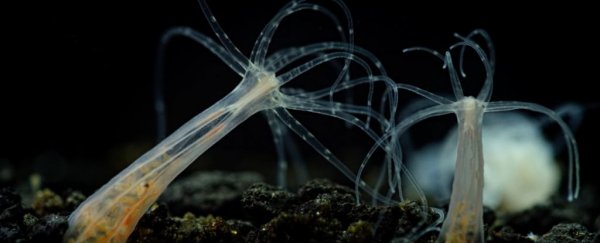A gene linked to the development of hearing in humans has just been linked to sensory development in sea anemones, too.
Called pou-iv (pow-four), the gene can be found in the tentacles of the starlet sea anemone (Nematostella vectensis), where it plays a crucial role in the animal's sense of touch.
Cnidaria, the phylum to which sea anemones belong, is the closest relative to Bilateria, animals with bilateral symmetry such as humans, diverging from their last common ancestor that lived around 748 to 604 million years ago.
The discovery of the gene's role in the starlet sea anemone suggests that it was present in their common ancestor and likely played a role in sensory development then, too.
"This study is exciting because it not only opened a new field of research into how mechanosensation develops and functions in a sea anemone .. but it also informs us that the building blocks of our sense of hearing have ancient evolutionary roots dating back hundreds of millions of years into the Precambrian," said biologist Nagayasu Nakanishi of the University of Arkansas.
In humans and other vertebrates, the sensory receptors of the auditory system are called hair cells. These cells have bundles of finger-like organelles called stereocilia that sense mechanical stimuli; namely, the vibrations we hear as sound. In mammals, pou-iv is required for the development of hair cells; we know this because mice that have had pou-iv knocked out are deaf.
The starlet sea anemone has similar mechanosensory hair cells on its tentacles, used for sensing movement. Little, however, was known about the anemone's pou-iv gene and what role, if any, it played in sensory development.
A team of researchers led by biologist Ethan Ozment of the University of Arkansas wanted to figure out what the gene was doing. The best way to do this is to disable the gene using the CRISPR-Cas9 gene-editing tool and observe what changes. So this is what the team did.
They injected a cocktail containing Cas9 protein into fertilized starlet sea anemone eggs to cut out the pou-iv gene, and studied the developing embryos, as well as the grown, mutated anemones.
Compared to wild-type control anemones, the mutant animals showed abnormal development of the tentacular hair cells, and showed no response to touch. Without pou-iv, the anemones were unable to sense mechanical stimuli via their hair cells.
In addition, knocking out pou-iv in the anemones significantly suppressed a gene very similar to the one which makes polycystin 1 that is found in vertebrates, where it is required for the sensing of fluid flow in kidneys. Sea anemones may not have kidneys, but sensing fluid flow would be a useful ability for marine animals.
Together, the researchers said, the results suggest that pou-iv played a role in the development of mechanosensory cells in the common ancestor between Cnidaria and Bilateria. To trace the gene back even further, however, will require data from other phyla with earlier divergence points.
"Our results indicate that the role for pou-iv in mechanoreceptor development is broadly conserved across Cnidaria and Bilateria," the researchers wrote in their paper.
"How early the role of pou-iv in mechanoreceptor differentiation emerged in animal evolution remains unresolved, and requires comparative data from placozoans and sponges, which are wanting."
The research has been published in eLife.
